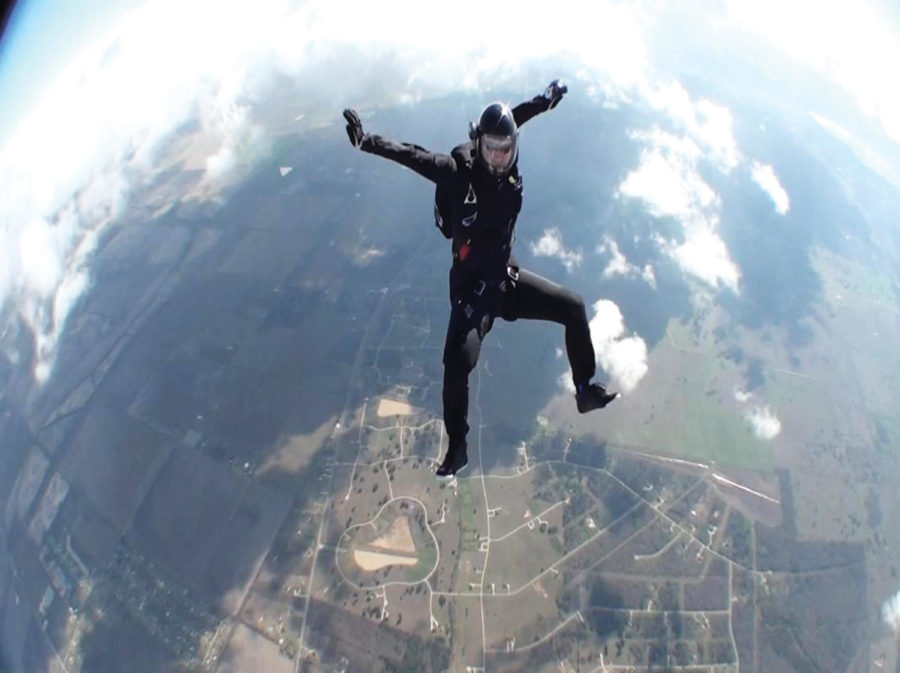Students reach new heights in Skydiving Club
Photo courtesy of ISU Skydiving Club
Skydiving Club
February 7, 2012
There really isn’t anything like that moment before a skydiver makes the jump. That twinge of fear, the rush of adrenaline — it’s enough to make you pull back.
But the Skydiving Club at Iowa State will push you to reach new limits.
“Making a leap from an airplane at 9,000 feet in the air into complete nothingness is an experience like nothing else,” said Craig Brown, junior in biochemistry and vice president of the club. “The free-fall portion of the skydive is an exhilarating rush that is tough to beat, and the canopy ride under your parachute and safe return to the ground is a relaxing experience that gives you one of the most beautiful views possible.”
Free flying is when jumpers fly in all orientations — most commonly upright or upside-down — and can fly over, under and around each other.
In canopy formation, jumpers open their parachutes immediately after exiting the airplane. They then fly their parachutes together and build formations by holding onto each other’s canopies.
A common misconception affiliated with skydiving is that only “crazy” people would jump out of an airplane.
“Many people think that skydiving is just jumping from the plane and falling straight down, but its much more than that,” Brown said. “It’s possible to fly your body in three dimensions, an experience unique to skydiving. Learning how to fly your body and make minute adjustments to your body position to get to where you want to go is one of the toughest things I’ve done in my life.
“I do it for the challenge.”
The club jumps regularly at several drop zones around Iowa, but they typically jump out of Accelerated FreeFall Iowa, the drop zone located in Boone.
Becoming a club member is as easy as requesting to join using the student organizations website. Currently, there are almost 250 registered members. Skydiving Club members typically make at least one skydive a year, with most of the experienced jumpers making anywhere between 50 to 200 skydives per year.
Safety is paramount in skydiving, and club members said the high risks are misconstrued.
“In the past, skydiving has been construed as a very dangerous sport, but the equipment and training has come a long way since skydiving’s beginnings,” Brown said. “There were 3 million skydives made last year; there were 21 fatalities. This translates to about a 0.0007 percent chance of fatality on your jump. There are obvious dangers to jumping from an airplane two miles in the air, but they are greatly exaggerated in popular culture.”
Skydiving isn’t the easiest thing to get involved with, but those who have given the sport a chance experience the benefits.
“Getting into the sport was intimidating at first, but having the support of fellow jumpers, especially women jumpers, was extremely helpful and the push I needed” said Sara Garton, senior in biology. “I used to have anxiety toward everything and through skydiving, I have let most of that go. I also smile a lot more.”
Camaraderie is another argument for joining the Skydiving Club.
“Skydiving is such a community sport,” Garton said. “Skydiving is a great place to meet some of the most amazing people. You’ll meet lifelong friends and continue to develop skills for the rest of your life.”
In order to become certified, jumpers must complete a course. First, jumpers need to go on a tandem skydive where you are attached to an instructor via a harness.
Garton completed the Accelerated FreeFall program. AFF is a fast-track learn-to-skydive program to take the everyday person from never jumping to being a qualified skydiver in eight levels — each level being one skydive.
This is the course geared for complete beginners who wish to learn to skydive in a few days of instruction. No previous experience is needed.
“In Colorado, I did AFF and got my A license, keeping the guys back in Iowa updated constantly with my progress,” Garton said. “It was a beautiful place to learn.”
Clark Coffman, associate professor of biology and club adviser, has high hopes for the future.
“The interest has always been there,” Coffman said. “The club’s goal is to help build awareness and facilitate and organize groups to jump. It is way more fun to jump with a group of people.”
Whether you enjoy the rush, camaraderie or challenge of skydiving, there is no question that the sport can be life-changing.
“Because of my experiences as a skydiver, I am a happier, stronger and braver person,” Garton said. “Not much scares me anymore and I refuse to let life pass me by because I was held back by fear.”

















